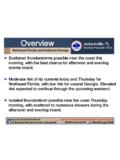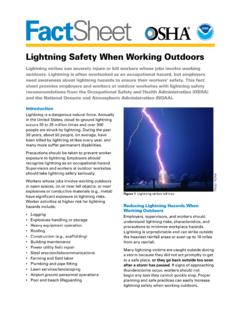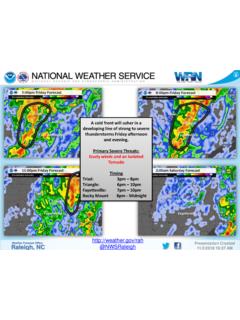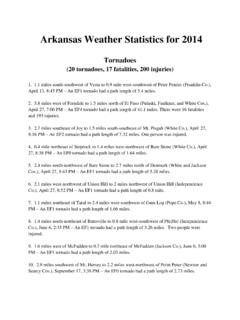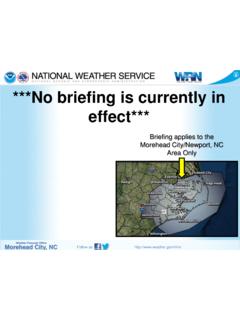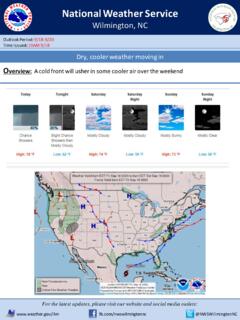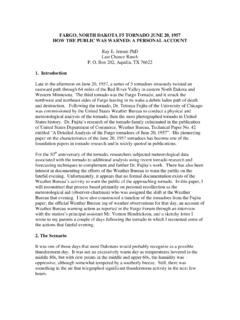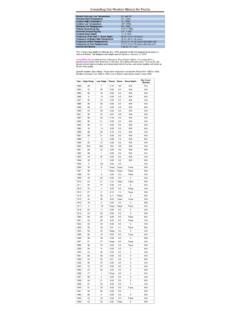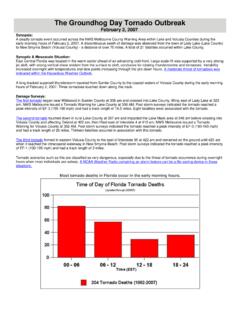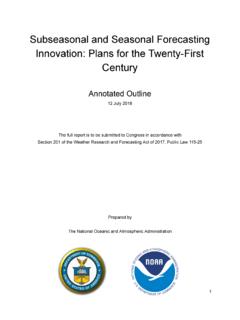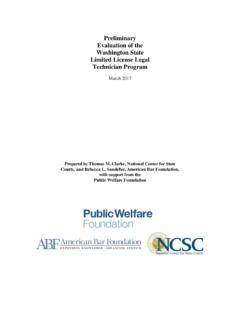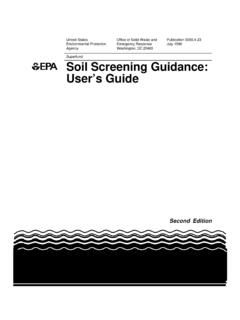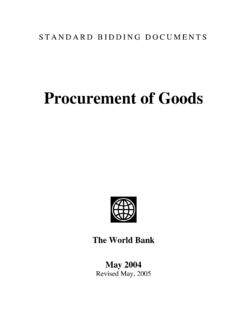Transcription of The Historic Derecho of June 29, 2012
1 Service Assessment The Historic Derecho of June 29, 2012 DEPARTMENT OF COMMERCE National Oceanic and Atmospheric Administration National Weather Service Silver Spring, Maryland ii Cover Photograph: Visible satellite image at 5 Eastern Daylight Time (EDT) June 29, 2012, as the Derecho moved across Ohio. National Lightning Data Network (NLDN) Cloud to ground (CG) lightning strikes for the 1-hour period, 4-5 EDT, are plotted in red. Surface observations are plotted in green. Smaller insets show radar reflectivity images of the Derecho during the afternoon and evening. iii Service Assessment The Historic Derecho of June 29, 2012 January 2013 National Weather Service Laura K. Furgione Acting Assistant Administrator for Weather Services iv Preface On June 29, 2012, a Derecho of Historic proportions struck the Ohio Valley and Mid-Atlantic states.
2 The Derecho traveled for 700 miles, impacting 10 states and Washington, The hardest hit states were Ohio, West Virginia, Virginia, and Maryland, a s well as Washington, The winds generated by this system were intense, with several measured gusts exceeding 80 mph. U nfortunately, 13 people were killed by the extreme winds, mainly by falling trees. An estimated 4 million customers lost power for up to a week. The region impacted by the Derecho was also in the midst of a heat wave. The heat, coupled with the loss of power, led to a life-threatening situation. Heat claimed 34 l ives in areas without power following the Derecho . Due to the significance of this event, the National Oceanic and Atmospheric Administration s National Weather Service formed a Service Assessment Team to evaluate the National Weather Service s performance before and during the event.
3 The findings and recommendations from this assessment will improve the quality of National Weather Service products and services and increase awareness related to severe thunderstorms and intense heat. The ultimate goal of this report is to help the National Weather Service better perform its mission of protecting life and property and enhancing the national economy. Laura K. Furgione Acting Assistant Administrator f or Weather Services January 2013 v Table of Contents Page Service Assessment viii Executive Summary .. ix 1. Introduction .. 1 NWS Mission .. 1 Purpose of Assessment Report .. 1 Methodology .. 1 Derecho Science and Climatology .. 3 3. Event Overview .. 5 4. Facts, Findings, Recommendations, and Best Practices .. 10 Model Performance .. 10 SPC Products and Services .. 12 WFO Pre-Event Services.
4 18 WFO Warning Services .. 20 NWSChat and Social Media .. 27 Service Backup .. 28 Spotter Activation and Training .. 29 StormReady Program .. 30 Equipment Failures .. 30 Post-Event Heat .. 31 5. Societal Responses and Impacts .. 34 Public Opinion Survey .. 34 Impacts of Warning Language and Lead Time .. 37 NOAA Weather Radio All Hazards and Siren Systems .. 38 Summary .. 39 A: Acronyms .. A-1 Appendix B: Findings, Recommendations, & Best Practices .. B-1 Appendix C: Direct Fatalities from the Derecho .. C-1 Appendix D: Heat-Related Fatalities in Areas Affected by the Derecho .. D-1 Appendix E: ASOS/AWOS Peak Wind Gusts > 57 mph .. E-1 Appendix F: Sample Impact-based Warning .. F-1 Appendix G: References .. G-1 vi Figures Figure 1: Number of derechos, 1980-2001, May through August .. 4 Figure 2: 8 Eastern Daylight Time, June 29, 2012, 500 millibar (mb) chart.
5 5 Figure 3: Surface map at 2 , June 29, 2012. Surface dewpoints greater than 66 degrees Fahrenheit ( F) are contoured in green. Courtesy of SPC .. 6 Figure 4: 12-hour forecast of CAPE from the NAM model valid at 8 , June 29, 2012 .. 6 Figure 5: Composite radar imagery showing the path of the Derecho . Courtesy of SPC .. 7 Figure 6: SPC preliminary storm reports for June 29, 2012. Blue dots indicate damaging wind reports. Black squares indicate measured wind gusts 74 mph or greater.. 8 Figure 7: WSR-88D Doppler radar reflectivity (left) and base velocity (right) from Northern Indiana (KIWX, top) and Sterling, VA (KLWX, bottom) as the Derecho approached Fort Wayne, IN, and Washington, The bright pink colors in the velocity data indicate wind speeds greater than 70 mph.. 9 Figure 8: 12-hour forecast of precipitation accumulation from the NAM model valid at 8 , June 29, 2012.
6 10 Figure 9: Observed radar reflectivity (left) and 10-hour forecast from the HRRR of radar reflectivity (right) valid at 5 , June 29, 2012 .. 11 Figure 10: 3:30 , Day 3 Convective Outlook valid June 29, 2012 .. 13 Figure 11: SPC's 1:30 , Day 2 Convective Outlook for June 29, 2012: left is categorical outlook, right is probability of all severe weather .. 14 Figure 12: The 9 , June 29, 2012, SPC Day 1 Convective Outlook (left) and damaging wind probabilities (right).. 14 Figure 13: The 4 , June 29, 2012, Day 1 Convective Outlook (left) and the 9 , Day 1 Convective Outlook (right) issued by the SPC.. 15 Figure 14: Severe Thunderstorm Watches issued during this event .. 15 Figure 15: Local extension of Severe Thunderstorm Watch #438 by WFO Sterling at 9:51 (left), and SPC s issuance of Severe Thunderstorm Watch #439 (right) at 10:10 .. 17 Figure 16: SPC Storm Reports for Saturday, June 30, 2012.
7 19 Figure 17: Google Map of warning polygons issued for the event. Darker line segments are where multiple polygons share a common boundary. Blue polygons are severe thunderstorm warnings, red are tornado warnings.. 21 Figure 18: Severe thunderstorm warning issued by WFO Charleston for 15 counties, 3 more than the 12 county system limit .. 22 Figure 19: Google representation of WarnGen polygon where damage report ( , the star) fell outside warning polygon because of 20 vertex limit .. 23 Figure 20: Graphical Nowcast issued by WFO Indianapolis during this event .. 26 Figure 21: SPS issued by WFO Sterling as the Derecho approached the metro area .. 27 Figure 22: Power outages by county in the Pittsburgh CWA (Wetzel and Monongalia County data unavailable), left, and area where the WFO lowered heat advisory criteria, shaded region, right.. 32 Figure 23: Example of impact-based heat advisory issued by WFO Charleston, WV.
8 33 vii Tables Table 1: NWR outages in WFO Sterling s CWA caused by the Derecho .. 31 Table 2: Power outage data by state provided by FEMA .. 31 viii Service Assessment Team The team consisted of the following individuals: Michael Vescio Team Leader: Meteorologist in Charge, Weather Forecast Office (WFO) Pendleton, OR Mark Fox Warning Coordination Meteorologist, WFO Fort Worth, TX Jennifer Henderson Candidate, Science and Technology Studies, Virginia Tech Mike Hudson Chief Operations Officer, National Weather Service (NWS) Central Region Headquarters, Kansas City, MO Dr. Susan Jasko Professor, Communication Studies, California University of Pennsylvania Ron Miller Science and Operations Officer, WFO Spokane, WA Dr. Laura Myers Research Professor, Social Scientist Research Center, Mississippi State University Nick Petro Warning Coordination Meteorologist, WFO Raleigh, NC Jim Scarlett Meteorologist in Charge, WFO Aberdeen, SD Alex Tardy Warning Coordination Meteorologist, WFO San D iego, CA Tyree Wilde Warning Coordination Meteorologist, WFO Portland, OR Stephen Wilkinson Warning Coordination Meteorologist, WFO Jackson, MS Other Valuable Contributors: David B.
9 Caldwell Director, Office of Climate, Water, and Weather Services (OCWWS), Silver Spring, MD Douglas C. Young Chief, OCWWS Performance Branch, Silver Spring, MD Salvatore Romano Evaluation Meteorologist, OCWWS Performance Branch, Silver Spring, MD Vankita Brown Social Scientist, OCWWS, Silver Spring, MD Brent MacAloney Meteorologist, OCWWS Performance Branch, Silver Spring, MD Melody Magnus Technical Editor, Innovim, Inc., NWS OCWWS, Silver Spring, MD ix Executive Summary On June 29, 2012, a devastating line of thunderstorms known as a Derecho (deh REY cho) moved east-southeast at 60 miles per hour (mph) from Indiana in the early afternoon to the Mid-Atlantic region around midnight. The states most significantly impacted were Indiana, Ohio, Kentucky, Pennsylvania, West Virginia, Maryland, Virginia, Delaware, New Jersey, and North Carolina, as well as Washington, Nearly every county impacted by this convective system suffered damages and power outages.
10 Winds were commonly above 60 mph with numerous reports of winds exceeding 80 mph. Some areas reported isolated pockets of winds greater than 100 mph. The storm resulted in 13 deaths, mainly a result of falling trees. One major impact from the Derecho was widespread power outages. More than 4 million customers were without power, some for more than a week after the storms moved through. To make matters worse, the area affected was in the midst of a prolonged heat wave. There were 34 heat-related fatalities in areas without power because of the Derecho . The National Weather Service (NWS) formed a Service Assessment Team to evaluate performance during this event. Due to the widespread nature of this Derecho , the team chose to visit the sites and review products and performance only at NWS Weather Forecast Offices (WFO) most impacted by the storms: WFOs Syracuse, IN (hereafter WFO Northern Indiana); Wilmington, OH; Pittsburgh, PA; Sterling, VA; Charleston, WV; and Blacksburg, VA.
